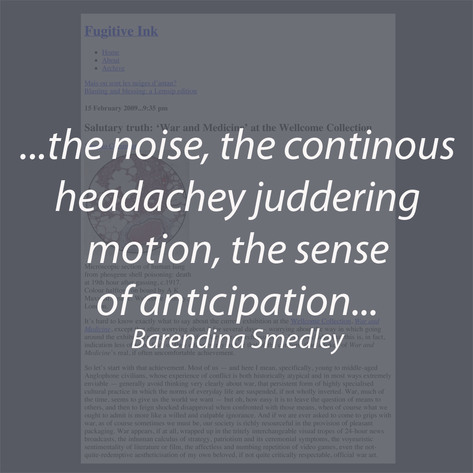fugitiveink : Salutary truth: 'War and Medicine' at the Wellcome Collection
Publication Title: fugitiveink.wordpress.comWriter: Barendina Smedley
Publication Date: 15th February 2009
[extract from article]
…War and Medicine acknowledges, clearly enough, that sense of distance. The exhibition opens with a film installation created by artist David Cotterrell, who in 2007 visited Helmand Province with the permission of the Joint Forces Medical Group. Here’s how the film is described in the PR material for the exhibition:
Theatre is a five-screen panoramic video projection that lasts 60 minutes, in which Cotterrell attempts to contextualise his experience of witnessing the treatment of combat victims in Camp Bastion, Afghanistan.
Actually, though, the film is nowhere near as vapid and disengaged as that 'attempts to contextualise' language might suggest. What it shows is, from memory, a group of Army medics simulating a medical rescue aboard a Hercules transport aircraft. As the low-key action plays out across three walls of a largish darkened room, we’re seated in the dark space against the fourth wall, rather as if we were there on the aircraft, dealing with the noise, the continous headachey juddering motion, the sense of anticipation and apprehension about what we’re about to experience ('disturbing images', anyone?) — stuck in a liminal space between two different realms of activity, each with its own defining codes of practice.
The film is, we are told on the way in, ‘a simulation of a simulation’ — and of course it’s perfectly true that this is just an exhibition’s safe, mediated, bloodless account of war and medicine, all second-hand and selective, occasionally unavoidably voyeuristic, shocking or marginally sentimental. And we know, of course, that when it’s over we can walk away and get on with the rest of our lives. The fourth side of the room that the exhibition cannot possibly begin to show is what it must be like to have to deal daily with the sort of issues raised here — not just the more obvious scars of war, either, like paraplegia or blindness, severe facial disfigurement or permanent brain damage, a lifetime of benefit dependence and unreliable mental health, but — closely related to that last, I suspect — the dislocation that occurs somewhere between the realities of war and peace. Mr Cotterrell illustrates this point very clearly in his essay ‘Artist’s Diary’ in the book version of War and Medicine:
"During my month-long stay in Helmand, two British soldiers died, 29 were wounded in action and there were 74 admissions to the field hospital. 71 Aeromed evacuations were recorded and an undisclosed number of civilian, insurgent and Afghan National Army soldiers were treated. I arrived back in Britain feeling a great sense of anger. I was frustrated by my previous ignorance of the frequency of injury. Soldiers are surviving wounds that would often have been fatal in previous conflicts. Body-armour, medical training and proximity of advanced surgery to the front-line have led to a ‘disproportionate’ number of casualties surviving. In the media, we hear about the deaths, with only occasional reference to the wounded. I came home assuming the violence I had witnessed in Afghanistan would be the focus of the news. But Reality TV, local politics and other less dramatic events occupied the headlines. For me, the incongruity between what I had seen and what was presented as the public face of conflict was, and continues to be, profound and irreconcilable.
"Paradoxically, however, the most earnest and passionate attempts to bridge this incongruity — not least, the excellent Helmand: The Soldiers’ Story at the National Army Museum — usually end up demonstrating how fundamentally unbridgeable it is."
That, I think, is the point of Theatre — its insistence both on the need for a journey, and on the necessary inadequacy of that journey. And that, in a sense, is also the point of the thoughtful, grave, fair-minded and bleakly fascinating War and Medicine. What to say about it all? Perhaps, in the end, the point lies less in saying anything, than in confronting, however obliquely, the terrible moral reality underpinning our world of nations, tribes, explicit and implicit doctrines. Humans, it turns out, can wound and also heal, hate and nurture, love and destroy — too often, indeed, do all these thing concurrently. At some level, of course, we knew all that already. Yet it’s the achievement of War and Medicine that it condenses the evidence for this into a handful of smallish rooms, eschewing easy answers. And in doing so, it renders unavoidable precisely that banal yet salutary truth which, under normal circumstances, we’d so much rather drown out with the sound of our own reassuring, oblivious, irrelevant voices.
Barendina Smedley
Download this file here, or click the image on the right.